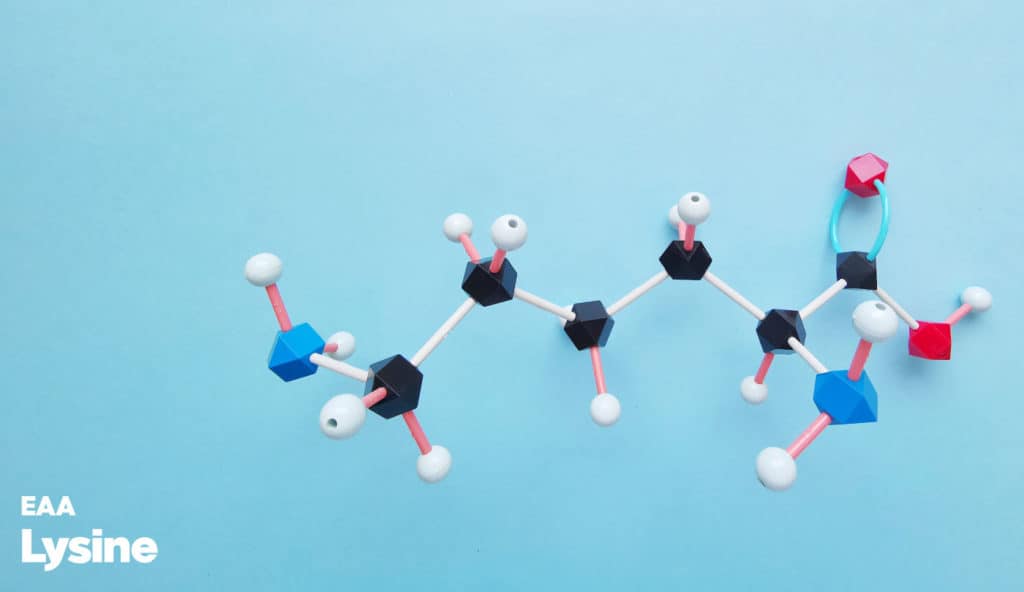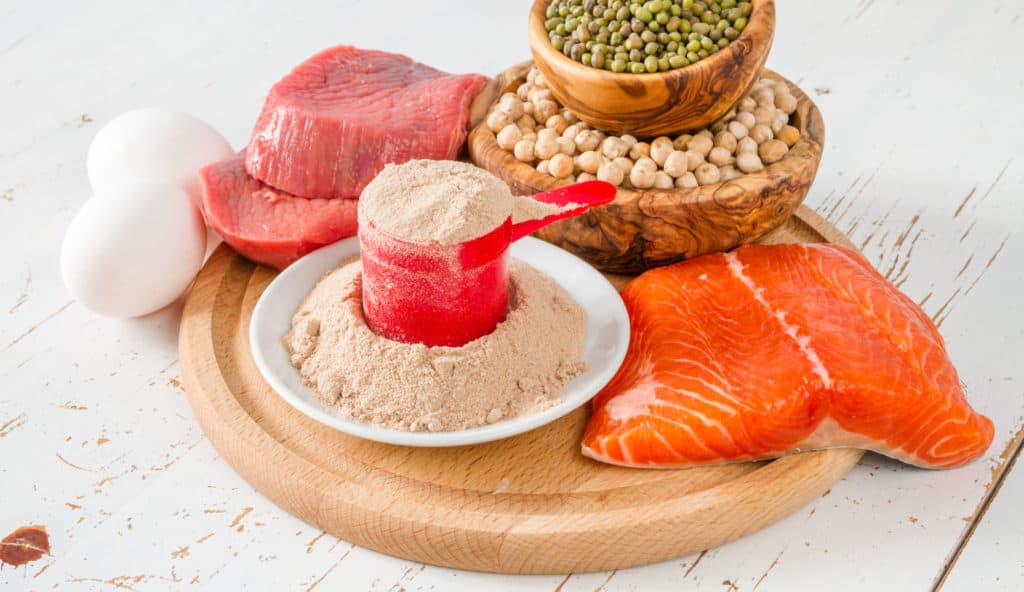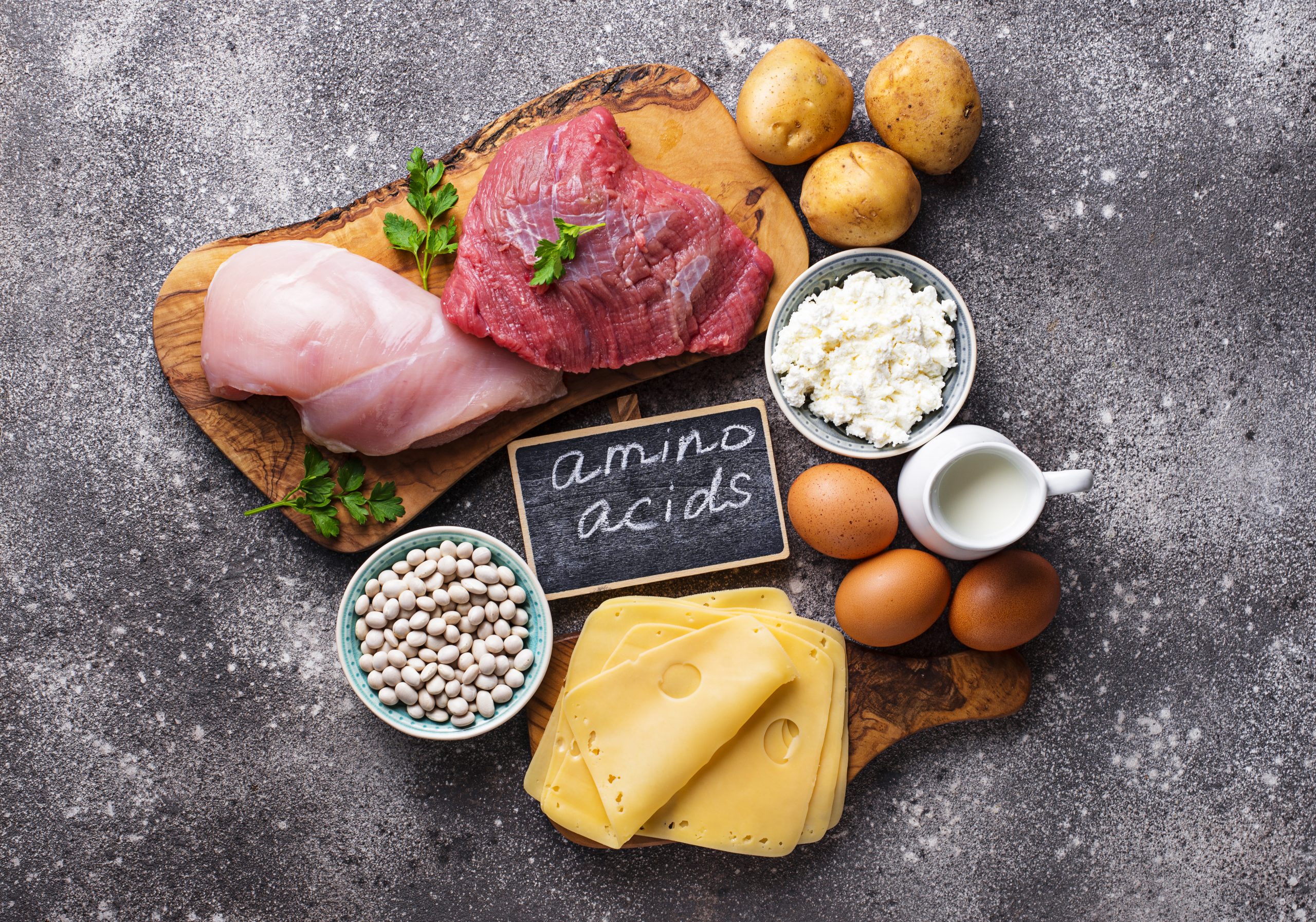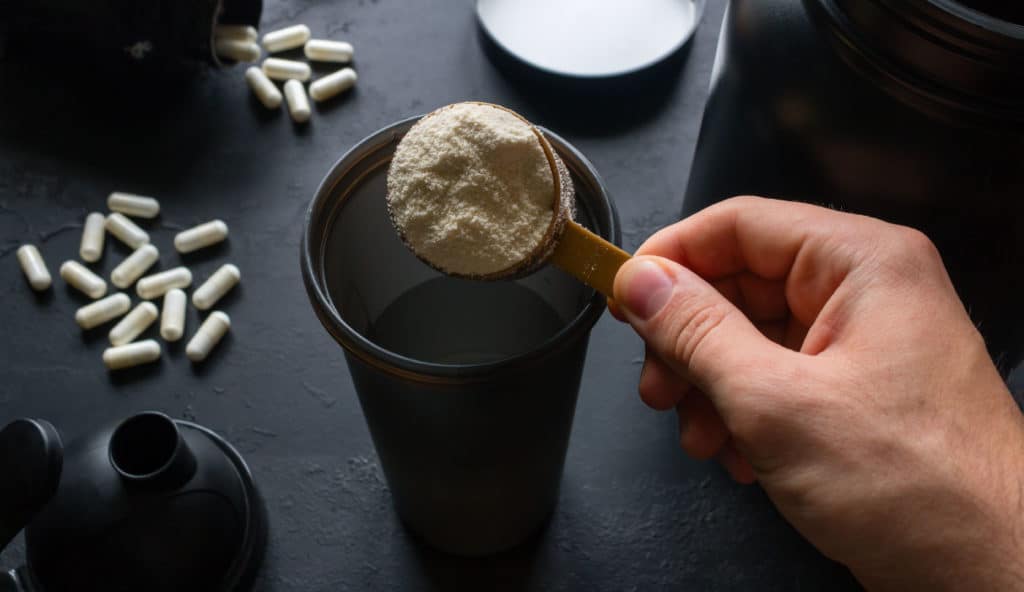Amino acid supplements have been popular for decades. For a long time, BCAAs were the amino acid supplement of choice. However, over the last ten years, EAAs having been taking the clear lead in preference among nutrition scientists. In this article we explain why EAAs are superior to BCAAs for protein synthesis and muscle growth.
At the turn of the 21st century though, branched-chain amino acids (BCAAs) proliferated and took over the intra-workout and post-workout supplement niches. Then EAAs started stealing their thunder. Despite the popularity of both supplements, there’s a lack of clear information explaining the difference between the two, but that’s what this article is all about!
The Key Point: EAAs are more effective than BCAAs at supporting protein synthesis and muscle growth.
Introduction
So, what’s the difference between EAAs and BCAAs? Are EAAs better than BCAAs? Should you be taking EAAs? This article will answer all your questions about these popular amino acid supplements and detail how they impact muscle growth.
We’ll also explore the market behind these supplement products, because let’s face it–overeager marketing teams often overpromise and underdeliver.
So we’ll bring you the hard science and clear facts so that you can make an informed choice as to what’s right for you and your fitness goals.
Essential Amino Acids vs. Nonessential Amino Acids

Before we dive into the EAAs vs. BCAAs debate, let’s briefly examine the 20 protein-creating amino acids that commonly occur in nature. These 20 amino acids are the veritable “building blocks” of proteins.
Since muscle protein is a major constituent of muscle tissue, amino acids play a vital role in muscle building. Thus amino acids are often the clear choice for supplement makers looking to give fitness enthusiasts a beneficial tool for pursuing their fitness goals.
Nine of the 20 amino acids necessary for muscle protein synthesis are nutritionally “essential” for humans, meaning we must consume them in the diet, or through–you guessed it–amino acid supplements.
These nine EAAs include:
- Histidine
- Isoleucine (BCAA)
- Leucine (BCAA)
- Lysine
- Methionine
- Phenylalanine
- Threonine
- Tryptophan
- Valine (BCAA)
Three of these nine EAAs are what’s known as branched-chain amino acids (BCAAs), which are so named due to their characteristic branching structure on a molecular level.
Thus, BCAAs are a subgroup of EAAs. We will discuss the difference between the full spectrum of EAAs and the three BCAAs in just a bit. But first let’s clarify the remaining group of amino acids.
A Helpful Analogy: Using BCAAs is like fielding a football team with only the Quarterback, Running Back and Wide Receiver. You’ll do a lot better with the full supporting cast (the EAAs!) of linemen as well.
What About ‘Non-Essential’ Amino Acids?
So what about the remaining 11 amino acids that don’t classify as “essential”?
Well, they are known as nonessential amino acids (NEAAs) since the body can synthesize them endogenously (a big word for “on its own”) from other molecules, such as glycerol from fat. If you happen to be lacking one (or several) of the NEAAs, your body can get by just fine for a while.
However, don’t misconstrue the above as saying the NEAAs are unnecessary in the diet. Quite the contrary, actually. Your body needs ample NEAAs for vital physiological processes, like creating neurotransmitters, enzymes, and peptide hormones.
Moreover, your body will break down proteins and use certain amino acids for energy if necessary (not ideal if you’re trying to build muscle). Fortunately, NEAAs are typically abundant in nature, and most protein-rich superfoods have a high proportion of these amino acids.
Here are the 11 NEAAs:
- Alanine
- Arginine
- Asparagine
- Aspartic acid
- Cysteine
- Glutamic acid
- Glutamine
- Glycine
- Proline
- Serine
- Tyrosine
Some of the NEAAs, notably L-alanine, L-glutamine, and L-arginine, are technically conditionally essential amino acids. This means they are a necessary component of the diet during certain stages of development and under adverse physiological stress, such as long bouts of intense strength training.
But the key point here is that while these NEAAs are naturally occurring in the human body, this does not mean that they will be naturally occurring at ideal levels in your body.
So if you have doubts about your nutrition, or if you perceive deficits in performance tied to any of these amino acids, you may want to consider supplementing them.
Should You Take EAAs or BCAAs?

Essential amino acids (EEAs), especially branch chain amino acids (BCAAs), aren’t always easy to come by in whole foods, particularly if you follow a vegan diet. Mother Nature decided to make plants less-robust sources of EAAs and BCAAs compared to dairy and animal meat.
If you are on a strict vegan or plant-based diet, supplementing with EAAs or BCAAs may be prudent. However, you’ll want to find a product that provides fermented BCAAs/EAAs—these are vegan-friendly amino acids. If the label doesn’t explicitly state that the amino acids are fermented or vegan, they are likely derived from animal products.
Now, if you’re someone who eats a lot of animal-based protein (e.g., beef, chicken, and dairy), taking an EAA supplement can still prove beneficial for muscle building and recovery. Since the amino acids in EAA supplements are free-form, they are quickly absorbed and rapidly increase muscle protein synthesis (assuming the proper ratio of essential amino acids is included in the formula).
So to answer the question of whether you should take these amino acids, you need to first establish two things: need and intention.
Do you believe your body needs these tools to take your fitness to the next level? What are you intentions or expectations for using these amino acids, and will they help you? To answer these questions we must first turn to the research.
What Does the Research Say?
To date, much of the research behind EAAs has taken place in clinical studies of sarcopenia and cachexia—medical conditions associated with muscle wasting. The findings of these studies are consistently promising, showing that modest doses of EAAs stimulate protein synthesis, mitigate muscle protein breakdown, and encourage muscle growth (even in patients on bed rest).
Technical jargon aside, EAAs enriched with BCAAs catalyze muscle building.
Naturally, essential amino acid supplements are growing in popularity as a pre-, intra-, and post-workout solution for muscle building and increasing strength. But are they better than BCAAs? Let’s see what research has to say about EAAs vs. BCAAs.
Are EAAs Better than BCAAs for Muscle Growth?

To reiterate, BCAAs are a subgroup of three EAAs: L-leucine, L-isoleucine, and L-valine. They are “branched-chain” amino acids due to their distinct chemical structures.
BCAAs have received considerable recognition in the sports supplement realm over the past decade due to their pivotal role in protein synthesis. Research suggests that BCAAs, especially L-leucine, are the “master regulators” of muscle protein synthesis.
Other studies corroborate that the proportion of L-leucine in a protein source directly affects the magnitude of muscle protein synthesis. In simpler terms: The more L-leucine in a complete protein source, the more muscle protein it creates.
But here’s the kicker…
While BCAAs are critical for initiating protein synthesis, they still need the help of the other six EAAs to create new muscle proteins. Hence, EAAs are taking over as the more applicable supplement for building muscle and promoting athletic performance.
This is why we are seeing such a resurgence in EAA’s popularity, because they play a crucial role in the functionality of BCAAs’ muscle building power.
BCAAs certainly have their place as a nutritional supplement, but the current body of evidence makes it pretty clear that all of the essential amino acids are necessary for optimal muscle protein synthesis, not just the BCAAs. If you lack any of the EAAs, protein synthesis will be limited accordingly.
Consider the analogy of making a pumpkin pie recipe from scratch, except you’re short on brown sugar. Is that pie going to taste as sweet and delicious as it normally would with all the ingredients? Of course not.
Another way to look at it: Each team in a game of football is supposed to have 11 players on the field at a time. If a team is missing one or two key players on offense during the game, they won’t be able to execute their plays as effectively.
Protein Synthesis from Essential Amino Acids (EAAs)

Muscle protein synthesis is no different. Every EAA is important; they are building blocks that work in concert to create new proteins. As such, the crown has to go to EAAs for muscle growth and recovery from exercise.
Intuitively then, gym-goers are quick to assume that slamming EAAs around the clock leads to “extra” muscle growth. Unfortunately, that’s not how things work, either. The body has an intrinsic “cap” to muscle protein synthesis after ingesting a sufficient amount of EAAs.
For example, drinking 20 grams of leucine-rich EAAs won’t lead to more muscle protein being created than drinking three times that amount of EAAs. Maybe a more relatable example is that eating a massive 2-lb porterhouse steak won’t lead to more muscle growth than eating 4 oz of steak.
This phenomenon is known as the “muscle-full” effect, and it’s suggested to last upwards of four hours after a meal.
Therefore, if your goal is to maximize muscle building, it’s wise to consume several ample—but not excessive—servings of protein/EAAs over the course of the day. For most people, this translates to about 30 grams of complete protein (e.g., whey protein, chicken breast, eggs) or 10 grams of pure EAAs.
The “muscle-full” phenomenon makes sense if you think about it: If there was no limit to muscle protein synthesis after consuming EAAs/protein, we could build infinite amounts of muscle mass simply by chugging EAAs once per day.
The salient takeaway here is that building muscle takes time; no matter how frequently you lift weights, you can’t expedite the process by consuming excessive amounts of EAAs and protein.
When Should You Take EAAs or BCAAs?

Regardless if you take EAAs or BCAAs, these supplements are ideal before, during, and/or after exercise. Many gym-goers will sip on essential amino acids as they go through their workout to support stamina and recovery.
If you eat a wholesome pre-workout meal and start exercising about an hour later, it’s probably best to wait and take EAAs immediately post-workout. If you end up training 2 to 3 hours after eating a protein-rich meal, then drinking BCAAs during your workout can help encourage protein synthesis since you’ll still have plenty of the other essential amino acids to work with from the pre-workout meal.
In most cases, EAAs can supplant the use of BCAAs, but the inverse isn’t necessarily true. For example, it’s unlikely that BCAAs will stimulate protein synthesis to a high degree if you haven’t eaten a protein-rich meal for 6+ hours. In such instances, BCAAs would be relegated to the role of reducing muscle protein breakdown.
EAAs, on the other hand, can provide the same anabolic response as complete protein sources, like whey protein. Some research has shown that taking EAAs after a workout stimulates protein synthesis as effectively as whey protein despite providing the same proportions of essential amino acids.
So what’s the takeaway here? Well it seems the science is clear: EAAs will almost always be an excellent choice for someone with fitness goals looking to optimize performance. BCAAs on the other hand make more sense for individuals looking to take existing optimization to a new level.
If your body’s store of EAAs is on point, then it will be appropriate to consider BCAAs to encourage new protein synthesis.
EAAs vs. BCAAs FAQs

What’s the Best Ratio of EAAs for Muscle Growth?
Extrapolating from research, the ideal ratio of EAAs for muscle protein synthesis is:
- Isoleucine: 10%
- Leucine: 20%
- Valine: 10%
- Threonine: 14%
- Lysine: 15%
- Methionine: 5%
- Tryptophan: 5%
- Histidine: 11%
- Phenylalanine: 10%
It’s not the end of the world if the ratio in your EAA supplement is slightly different. However, the BCAAs in a 2:1:1 ratio of leucine to isoleucine and valine is crucial. Make sure you find an EAA supplement that provides plenty of L-leucine; having “more than enough” is better than not enough.
So make sure your brand of amino acids doesn’t skimp on doses where it really counts!
EAAs would be the more fitting option if you are following an intermittent-fasting regimen.
However, be aware that protein synthesis is an energy-consuming process that counteracts fat-burning pathways. Consuming EAAs during a fast will help protect against muscle tissue breakdown, but it will also reduce the use of fat for energy.
In other words, you have to decide if the trade-off is worth it.
Do I Still Need to Eat Protein if I Take EAAs?
Yes! EAAs are not a replacement for a balanced diet with plenty of protein from whole foods. Use EAAs as a supplement to your diet, not a substitute.
Particularly when you are very active and place the body under regular physical stress, you need to think of EAAs as additional fuel–not the only fuel.
What’s Better for Post-Workout: EAAs or Whey Protein?
This is a question that has no clear-cut answer since it depends on a range of factors. If anything, we can safely say that it’s a draw between EAAs and whey protein—both are great options as post-workout supplements for kickstarting the muscle-repair process.
The main difference is that the amino acids in an EAA supplement are not bonded together like they are in whey protein, so the former requires minimal digestion and is absorbed rapidly. However, this doesn’t appear to make much of a difference in the context of building muscle.
This gives some freedom to the consumer to decide which product they like best in this context.
What’s the Best EAA Supplement?

Now that you know the differences between EAAs and BCAAs, the next step is finding the right amino acid supplement for your needs. To help make the process easier, be sure to check out our list of the best EAA supplements if you’re on the hunt for a quality EAA formula to replenish you before, during, and after workouts!
But remember the information that we have presented above! Disregard EAA supplements that promise things to good to be true. Ultimately, the body’s most stringent inhibitor of optimization is its own capacity of function.
Meaning that there’s no shortcuts when it comes down to hard work in exercise.
Choosing the right amino acid supplement will require an accurate self appraisal: where are you currently in achieving your goals, and what are your needs in order to do better?
If you’re supplement game is already on point, and you find results lacking, then return to the basics. Is your diet less optimized than you previously thought? In the end, professional consultation may provide the most clarity and actionable information.
Consider seeking out a local sports nutritionist if you find yourself lost on what to do next.
